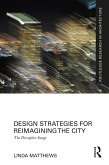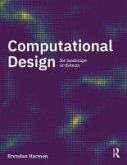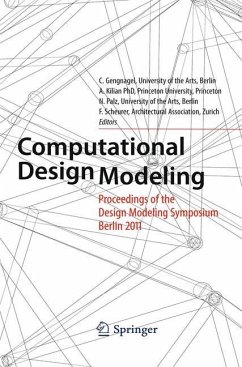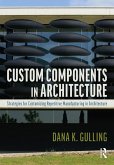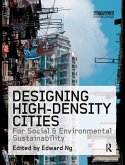Amjad Almusaed, Asaad Almssad, Ibrahim Yitmen
Mars Architecture
Construction 6.0 for Designing Sustainable and Health-Oriented Habitats
Amjad Almusaed, Asaad Almssad, Ibrahim Yitmen
Mars Architecture
Construction 6.0 for Designing Sustainable and Health-Oriented Habitats
- Gebundenes Buch
- Merkliste
- Auf die Merkliste
- Bewerten Bewerten
- Teilen
- Produkt teilen
- Produkterinnerung
- Produkterinnerung
This book combines Construction 6.0 with AEC principles for designing sustainable, health-focused Martian habitats. It unveils innovative architectural designs ideal for Mars, utilizing 3D printing, autonomous robotics, and regolith, alongside renewable energy and life support systems.
Andere Kunden interessierten sich auch für
![Design Strategies for Reimagining the City Design Strategies for Reimagining the City]() Linda MatthewsDesign Strategies for Reimagining the City137,99 €
Linda MatthewsDesign Strategies for Reimagining the City137,99 €![Computational Design for Landscape Architects Computational Design for Landscape Architects]() Brendan HarmonComputational Design for Landscape Architects167,99 €
Brendan HarmonComputational Design for Landscape Architects167,99 €![Computational Design Modeling Computational Design Modeling]() Computational Design Modeling154,99 €
Computational Design Modeling154,99 €![Custom Components in Architecture Custom Components in Architecture]() Dana GullingCustom Components in Architecture161,99 €
Dana GullingCustom Components in Architecture161,99 €![Design Computing Design Computing]() Brian JohnsonDesign Computing250,99 €
Brian JohnsonDesign Computing250,99 €![Sustainable Housing in a Circular Economy Sustainable Housing in a Circular Economy]() Avi FriedmanSustainable Housing in a Circular Economy161,99 €
Avi FriedmanSustainable Housing in a Circular Economy161,99 €![Designing High-Density Cities Designing High-Density Cities]() Designing High-Density Cities197,99 €
Designing High-Density Cities197,99 €-
-
-
This book combines Construction 6.0 with AEC principles for designing sustainable, health-focused Martian habitats. It unveils innovative architectural designs ideal for Mars, utilizing 3D printing, autonomous robotics, and regolith, alongside renewable energy and life support systems.
Hinweis: Dieser Artikel kann nur an eine deutsche Lieferadresse ausgeliefert werden.
Hinweis: Dieser Artikel kann nur an eine deutsche Lieferadresse ausgeliefert werden.
Produktdetails
- Produktdetails
- Verlag: Taylor & Francis Ltd
- Seitenzahl: 274
- Erscheinungstermin: 26. Juni 2025
- Englisch
- Abmessung: 234mm x 156mm
- Gewicht: 453g
- ISBN-13: 9781032963709
- ISBN-10: 1032963700
- Artikelnr.: 73390455
- Herstellerkennzeichnung
- Libri GmbH
- Europaallee 1
- 36244 Bad Hersfeld
- gpsr@libri.de
- Verlag: Taylor & Francis Ltd
- Seitenzahl: 274
- Erscheinungstermin: 26. Juni 2025
- Englisch
- Abmessung: 234mm x 156mm
- Gewicht: 453g
- ISBN-13: 9781032963709
- ISBN-10: 1032963700
- Artikelnr.: 73390455
- Herstellerkennzeichnung
- Libri GmbH
- Europaallee 1
- 36244 Bad Hersfeld
- gpsr@libri.de
Amjad Almusaed is a scholar specializing in the relationship between architecture and environmental design. He earned a Ph.D. from Ion Mincu University in Bucharest, Romania. In 2004, he undertook postdoctoral research at the School of Architecture in Aarhus, Denmark, focusing on sustainable and bioclimatic housing. This study highlighted his strong dedication to incorporating sustainability ideas into building design and urban planning. He has conducted thorough study, research, and technical assessments in these crucial areas throughout his academic career. Professor Almusaed has made substantial contributions to the scholarly community as an editor and reviewer. He has taken on editorial duties for several prestigious publications, such as those from MDPI and Open Intech, He has curated and edited more than 15 volumes on various topics such as architecture, urbanism, smart cities, and energy-efficient structures. He has authored five monographs and textbooks, reflecting his research focus on environmental sustainability in design. He has demonstrated his dedication to academic excellence by participating in peer reviewing over 200 academic articles for renowned publishers. His commitment to upholding intellectual honesty and advancing research in the field of architecture is evident in this area of his professional life. Professor Almusaed is involved in several architectural organizations globally in addition to his accomplishments as an editor and author. His commitment to fostering worldwide dialogues on sustainable and ecologically conscious design techniques is evident in this collaboration. He has published over 185 academic works, such as articles, studies, books, and book chapters in many languages, making significant contributions to the academic discussion on architecture and sustainability. His bibliography demonstrates a career dedicated to spreading and progressing knowledge in his area, establishing him as a key player in the discussion of incorporating sustainable and bioclimatic concepts in architecture and urban planning. Throughout his academic path, he has consistently sought information and shown a strong commitment to improving the sustainability of our built surroundings. Ibrahim Yitmen has a PhD in Architecture from Istanbul Technical University, Turkey. He has been a Professor in Management of Construction Production at Jönköping University, Sweden since February 2018. His research focus is mainly on Innovation in Construction involving socio-technical issues regarding digital transformation in AEC industry, and his recent special interest is on Digital Twin-based Smart Built Environment, Construction 5.0 and Sustainable Resilient Habitats, Augmented Reality/Mixed Reality for Cognitive Buildings, Integration of Digital Twins and Deep Learning for Smart Planning and Construction, and Blockchain Technology in Construction Supply Chains. Professor Yitmen has published more than 140 research papers in refereed international journals and in peer reviewed conference proceedings. He has 2 recent edited volumes to his credit. He was one of the guest editors of the MDPI Journal Applied Sciences for the Special Issue "Cognitive Buildings". Professor Yitmen serves on the scientific committees of the international conferences held by the International Council for Research and Innovation in Building and Construction, American Society of Civil Engineers, and European Council on Computing in Construction. Dr Yitmen is reviewer of several important peer-reviewed journals. He has been an active Member of American Society for Engineering Management, USA since 2010. Asaad Almssad, a distinguished civil engineering scholar with over 30 years of experience, has contributed significantly to academia, industry, and research. Holding position at Karlstad University in Sweden, as well as international entities, his work focuses on building materials, structural engineering, sustainable construction practices, and energy efficiency in building systems. Professor Almssad's scholarly achievements include over sixty research papers and several authored books, marking him as a prominent figure in his field. He is notably recognized for his expertise in sustainable construction and structural engineering, offering consultancy on incorporating green practices into construction projects. His textbook, "Concrete and Construction," widely used in Swedish universities, bridges the gap between theoretical knowledge and practical application in concrete technology and construction practices. As a docent at Karlstad University, Professor Almssad continues to influence the future of sustainable construction and structural engineering through his research and teaching, mentoring the next generation of engineers and researchers. His commitment to advancing sustainable construction practices highlights his role as a key contributor to the field of civil engineering.
Preface. Introduction. I. FOUNDATIONS OF MARTIAN SETTLEMENTS. Introduction
to Martian Environments and Settlement Challenges: Overview of Martian
Conditions and the Challenges of Establishing Human Habitats. A Comparative
Analysis of Terrestrial Climates: Assessing the Distinctions between
Martian and Terrestrial Environments and Their Implications for Habitat
Design. Integrating AEC Innovations for Martian Settlements: Practical
Applications of Construction 6.0 in Designing Sustainable and
Health-oriented Habitats in Extraterrestrial Environments. II.
TECHNOLOGICAL ADVANCES AND SUSTAINABLE LIVING. Advancements in 3D Printing
and Autonomous Robotics: Utilization of Cutting-edge Technologies for
Constructing Sustainable Habitats on Mars. Incorporating Health-oriented
Architectural Principles: Emphasizing the Critical Role of Spatial
Ergonomics, Air Quality, and Biophilic Design in Ensuring the Well-being
and Survival of Mars Residents. III. BUILDING A SELF-SUSTAINING MARTIAN
COMMUNITY. Enhancing Life Support Systems in Martian Settlements: The
Pivotal Role of Digital Twin Technology in Optimizing Habitat Management.
Construction 6.0: Redefining Martian Infrastructure Development-An In-depth
Analysis of the Construction 6.0 Approach for Developing Durable and
Livable Martian Environments. The Ethics of Martian Colonization:
Addressing Ethical Considerations and the Responsibility towards Martian
environments and Potential Life Forms. A Thorough Review of the Practical
and Theoretical Challenges in Building Sustainable, Health-focused
Extraterrestrial Settlements. The Prospective Trajectory of Martian Habitat
Development: Innovations in Construction, Architecture, and Urban Planning.
Index.
to Martian Environments and Settlement Challenges: Overview of Martian
Conditions and the Challenges of Establishing Human Habitats. A Comparative
Analysis of Terrestrial Climates: Assessing the Distinctions between
Martian and Terrestrial Environments and Their Implications for Habitat
Design. Integrating AEC Innovations for Martian Settlements: Practical
Applications of Construction 6.0 in Designing Sustainable and
Health-oriented Habitats in Extraterrestrial Environments. II.
TECHNOLOGICAL ADVANCES AND SUSTAINABLE LIVING. Advancements in 3D Printing
and Autonomous Robotics: Utilization of Cutting-edge Technologies for
Constructing Sustainable Habitats on Mars. Incorporating Health-oriented
Architectural Principles: Emphasizing the Critical Role of Spatial
Ergonomics, Air Quality, and Biophilic Design in Ensuring the Well-being
and Survival of Mars Residents. III. BUILDING A SELF-SUSTAINING MARTIAN
COMMUNITY. Enhancing Life Support Systems in Martian Settlements: The
Pivotal Role of Digital Twin Technology in Optimizing Habitat Management.
Construction 6.0: Redefining Martian Infrastructure Development-An In-depth
Analysis of the Construction 6.0 Approach for Developing Durable and
Livable Martian Environments. The Ethics of Martian Colonization:
Addressing Ethical Considerations and the Responsibility towards Martian
environments and Potential Life Forms. A Thorough Review of the Practical
and Theoretical Challenges in Building Sustainable, Health-focused
Extraterrestrial Settlements. The Prospective Trajectory of Martian Habitat
Development: Innovations in Construction, Architecture, and Urban Planning.
Index.
Preface. Introduction. I. FOUNDATIONS OF MARTIAN SETTLEMENTS. Introduction
to Martian Environments and Settlement Challenges: Overview of Martian
Conditions and the Challenges of Establishing Human Habitats. A Comparative
Analysis of Terrestrial Climates: Assessing the Distinctions between
Martian and Terrestrial Environments and Their Implications for Habitat
Design. Integrating AEC Innovations for Martian Settlements: Practical
Applications of Construction 6.0 in Designing Sustainable and
Health-oriented Habitats in Extraterrestrial Environments. II.
TECHNOLOGICAL ADVANCES AND SUSTAINABLE LIVING. Advancements in 3D Printing
and Autonomous Robotics: Utilization of Cutting-edge Technologies for
Constructing Sustainable Habitats on Mars. Incorporating Health-oriented
Architectural Principles: Emphasizing the Critical Role of Spatial
Ergonomics, Air Quality, and Biophilic Design in Ensuring the Well-being
and Survival of Mars Residents. III. BUILDING A SELF-SUSTAINING MARTIAN
COMMUNITY. Enhancing Life Support Systems in Martian Settlements: The
Pivotal Role of Digital Twin Technology in Optimizing Habitat Management.
Construction 6.0: Redefining Martian Infrastructure Development-An In-depth
Analysis of the Construction 6.0 Approach for Developing Durable and
Livable Martian Environments. The Ethics of Martian Colonization:
Addressing Ethical Considerations and the Responsibility towards Martian
environments and Potential Life Forms. A Thorough Review of the Practical
and Theoretical Challenges in Building Sustainable, Health-focused
Extraterrestrial Settlements. The Prospective Trajectory of Martian Habitat
Development: Innovations in Construction, Architecture, and Urban Planning.
Index.
to Martian Environments and Settlement Challenges: Overview of Martian
Conditions and the Challenges of Establishing Human Habitats. A Comparative
Analysis of Terrestrial Climates: Assessing the Distinctions between
Martian and Terrestrial Environments and Their Implications for Habitat
Design. Integrating AEC Innovations for Martian Settlements: Practical
Applications of Construction 6.0 in Designing Sustainable and
Health-oriented Habitats in Extraterrestrial Environments. II.
TECHNOLOGICAL ADVANCES AND SUSTAINABLE LIVING. Advancements in 3D Printing
and Autonomous Robotics: Utilization of Cutting-edge Technologies for
Constructing Sustainable Habitats on Mars. Incorporating Health-oriented
Architectural Principles: Emphasizing the Critical Role of Spatial
Ergonomics, Air Quality, and Biophilic Design in Ensuring the Well-being
and Survival of Mars Residents. III. BUILDING A SELF-SUSTAINING MARTIAN
COMMUNITY. Enhancing Life Support Systems in Martian Settlements: The
Pivotal Role of Digital Twin Technology in Optimizing Habitat Management.
Construction 6.0: Redefining Martian Infrastructure Development-An In-depth
Analysis of the Construction 6.0 Approach for Developing Durable and
Livable Martian Environments. The Ethics of Martian Colonization:
Addressing Ethical Considerations and the Responsibility towards Martian
environments and Potential Life Forms. A Thorough Review of the Practical
and Theoretical Challenges in Building Sustainable, Health-focused
Extraterrestrial Settlements. The Prospective Trajectory of Martian Habitat
Development: Innovations in Construction, Architecture, and Urban Planning.
Index.


